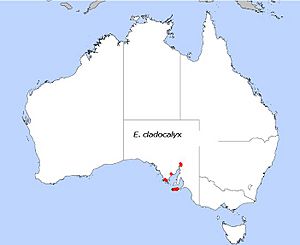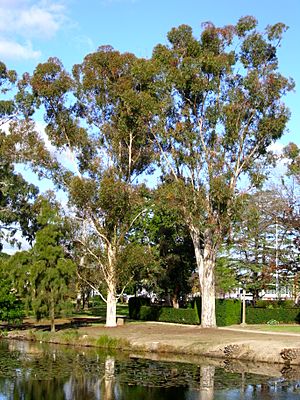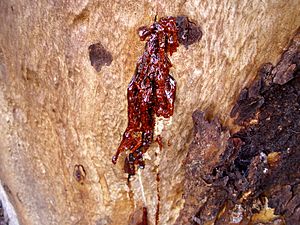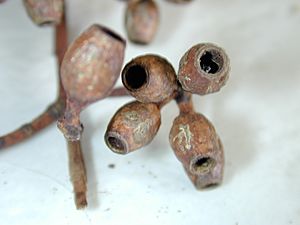Sugar gum facts for kids
Quick facts for kids Sugar gum |
|
|---|---|
 |
|
| Eucalyptus cladocalyx habit | |
| Scientific classification | |
| Genus: |
Eucalyptus
|
| Species: |
cladocalyx
|
 |
|
| E. cladocalyx, field distribution | |
| Synonyms | |
|
Eucalyptus corynocalyx F.Muell. nom. illeg., nom. superfl. |
|

The Sugar Gum (scientific name: Eucalyptus cladocalyx) is a type of eucalypt tree. It grows naturally in South Australia, a state in Australia. You can find it in three main areas: the Flinders Ranges, the Eyre Peninsula, and Kangaroo Island.
Contents
What Does a Sugar Gum Look Like?
The Sugar Gum tree is easy to spot because of its cool, patchy bark. The old, smooth grey bark peels off in uneven pieces. This shows the fresh, yellow-brown bark underneath, which then changes to yellow or orange.
Its leaves are shiny and have two different colors. The top side is a darker green, and the underside is much paler. These leaves are usually shaped like a spear and are about 8 to 17 centimeters long.
The tree has creamy-white flowers that bloom in summer. These flowers grow in groups on small branches that don't have leaves. After the flowers, the tree produces barrel-shaped fruits. Inside these fruits are small, light grey to brown seeds.
How Big Do Sugar Gums Get?
Sugar Gums from the Flinders Ranges can grow very tall, up to 35 meters (about 115 feet) high. They have a straight trunk and branches that start about halfway up the tree. Each main branch forms its own small leafy top. These tall trees are often planted on farms to block wind or for their wood.
However, Sugar Gums on the Eyre Peninsula and Kangaroo Island are usually shorter. They are typically between 8 to 15 meters (about 26 to 49 feet) tall. These trees often have trunks that are not straight. Their leafy tops are more open and spread out, reaching about 12 to 15 meters wide.
Sugar Gum's Family Tree
The Sugar Gum was first officially described by a botanist named Ferdinand von Mueller in 1853. He wrote about it in a science journal.
Later, in 2013, another botanist named Dean Nicolle found that there are three different types, or subspecies, of Sugar Gum. These types are:
- Eucalyptus cladocalyx subspecies cladocalyx: This type is shorter and spreads out more. It has short, wide leaves and bigger fruits.
- Eucalyptus cladocalyx subspecies crassa: This is the tallest type of Sugar Gum. It has long, narrow leaves and large fruits.
- Eucalyptus cladocalyx subspecies petila: This type is also tall but has branches that grow straight up. It has narrow adult leaves and smaller fruits.
The scientific name cladocalyx comes from ancient Greek words. Klados means "branch" or "twig," and kalyx means "cup" or "cover." This name refers to how the flowers grow on leafless branches.
Where Sugar Gums Grow
The Sugar Gum is native only to the southern parts of South Australia. It grows naturally in three main areas: the southern and central-eastern parts of the Eyre Peninsula, most of the Flinders Ranges, and on Kangaroo Island. Scientists think these trees are leftovers from forests that grew in wetter times long ago.
Today, Sugar Gums have also started growing on their own in other places. You can find them in the South West region of Western Australia and in southern Victoria. They have also spread to other countries like parts of Africa, California, Hawaii, Israel, and Spain.
Each of the three subspecies grows in a specific area:
- Subspecies cladocalyx is found only on the southern and eastern Eyre Peninsula.
- Subspecies crassa grows on Kangaroo Island.
- Subspecies petila is found in the southern Flinders Ranges.
Uses of the Sugar Gum Tree
Sugar Gums are often planted across southern Australia. Farmers use them to create windbreaks, which protect their land from strong winds. The trees are also grown for their wood and for firewood.
The wood of the Sugar Gum is strong and lasts a long time. It can even resist termites! People use its wood for making furniture, flooring, fence posts, and even railway sleepers.
This tree grows quickly and likes sunny spots with clay, loam, or sandy soils. It is good at using water efficiently and can handle both dry weather and frost. Its flowers attract bees, which helps with pollination. The Sugar Gum is also a good home for the Yellow-tailed Black-Cockatoo, a type of bird.
Sugar Gums are well-suited to bushfires. They can grow new shoots from their trunk and branches after a fire. They also spread many seeds by wind after a fire.
The wood from the center of the tree is a pale yellow-brown color. It is very hard and heavy.
Sugar Gums in Gardens
The subspecies cladocalyx is sometimes sold in plant nurseries as E. cladocalyx 'Nana'. This means it's a smaller, more compact version that can be grown in gardens.
See also
 In Spanish: Eucalipto de azúcar para niños
In Spanish: Eucalipto de azúcar para niños
Images for kids
-
Two sugar gums growing next to the Wollundry Lagoon in Wagga Wagga









